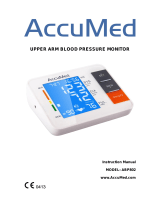
What the results mean
a. The LCD screen will automatically display the systolic and diastolic pressure
reading in mmHg and the pulse rate in pulse/min after each measurement.
b. Record date, time, systolic reading, diastolic reading and pulse rate on your record card
which you will find in the pack (including anything that may have influenced
your blood pressure reading e.g. stress, anxiety). This will help you monitor
trends. Please take this record card with you on your visits to your doctor,
pharmacist or healthcare professional.
Measurements should ideally be taken at the same time, under the same conditions and in the same
position each time.
Please be aware that blood pressure can fluctuate since it responds to minute changes in the body. It is unusual for it to
continuously remain at the same value, hence it is recommended that the blood pressure be determined based on an
average of multiple measurements. If you experience a higher than normal reading, do not panic as this can happen.
Relax and take a break for at least 10 minutes before measuring your blood pressure again. Low blood pressure
(Hypotension) and high blood pressure (Hypertension) can only be diagnosed by a qualified healthcare professional,
such as a doctor, pharmacist. If you have any concerns or questions, please contact your pharmacist or healthcare
professional.
Measure one hour after eating and avoid measuring immediately after bathing.
Measure one hour after smoking or drinking alcohol/coffee.
Relax for 10-20 minutes before taking a measurement and remain relaxed whilst measuring.
Do not move or talk during measurement, as this will affect the accuracy.
Do not use this monitor if you suffer from atrial or ventricular premature beats or atrial fibrillation.
To get an accurate value:
Using your Blood Pressure Monitor
10






















